
DOC. MIE91093 Rev. 1.34
Page 64 of 145
1.8.4. Angle threshold
We start from a situation where:
. Amplitudes are the same, and equal to VN;
. Phase is different: it can be more or less than zero; two
angle thresholds, A> and A<, will be found;
. Frequency is the same (the mains).
From this, we will modify the phase angle, until the relay trips:
this is the angle threshold. The test will be performed first with
A > 0°, and then with A < 0°.
. Press ON, and adjust V1 to VN.
. Press OFF, and adjust V2 to VN.
. Press ON, and adjust the phase angle of V2 with respect to
V1 at a value outside the permission (for instance, 45°):
AUX VAC/VDC > Aux VAC control > Phase > Reference :
voltage> (Value) (RET)
. Now, check that the relay is not tripped, and then slowly
reduce the phase angle until the relay trips: at this moment,
confirm save results pressing the multi-function knob, and
proceed: the high angle threshold A> is found.
. Next, we find the drop-off threshold for A>. From the angle
above, slowly increase it; as the relay resets, confirm save
results pressing the multi-function knob, and proceed.
Now, repeat the procedure for A<. The starting angle will be
less than 0° (for instance, 315°); the threshold and drop-off
for A< are found.
1.8.5. Frequency threshold
The frequency test is much more difficult, because any
frequency slip between two voltages, leads to a phase angle
shift between them. An example will better explain what
happens.
Let’s consider the first voltage V1 at FNOM: it could be
represented by a vector turning at 50 (6) rounds per second.
Consider now the second voltage V2 at 50.1 Hz: it could be
represented by a vector turning at 50.1 rounds per second.
















































